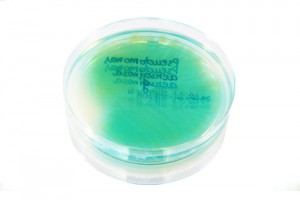New Insights Into Pseudomonas Aeruginosa’s Mechanisms Could Impact CF Treatments
Written by |

 New research on the mechanism of infection of the bacteria Pseudomonas aeruginosa entitled “Surface attachment induces Pseudomonas aeruginosa virulence” by Dr. Albert Siryaporn at Princeton University was recently published in PNAS. The findings are particularly important to the Cystic Fibrosis community, as Pseudomonas aeruginosa is a serious threat to CF patients’ health.
New research on the mechanism of infection of the bacteria Pseudomonas aeruginosa entitled “Surface attachment induces Pseudomonas aeruginosa virulence” by Dr. Albert Siryaporn at Princeton University was recently published in PNAS. The findings are particularly important to the Cystic Fibrosis community, as Pseudomonas aeruginosa is a serious threat to CF patients’ health.
The bacterium Pseudomonas (P.) aeruginosa is a pathogen that lives in many types of environments and infects a wide range of hosts, including mammals, insects, worms, amoeba, and fungi. Early in the infection, P. aeruginosa attaches to the cell surface of the host, and this binding acts as a signal for P. aeruginosa to become virulent.
Prof. Zemer Gitai said that viruses and other pathogens depend on “taste,” since they respond to specific chemical signals associated to the hosts with which they co-evolved. Nevertheless, by binding to the cell surface, Pseudomonas can infect humans, plants, animals, water and soil.
“Pseudomonas‘ ability to infect anything was known before. What was not known was how it’s able to detect so many types of hosts,” said Prof. Zemer Gitai, Princeton associate professor of molecular biology, in a press release. “That’s the key piece of this research — by using this sense of touch, as opposed to taste, Pseudomonas can equally identify any kind of suitable host and initiate infection in an attempt to kill it.”
In this study, the researchers found that Pseudomonas can only begin an infection if they bind to a surface and feel the “quorum sensing,” a mechanism that the bacteria use to feel the presence of large amount of bacteria from the same strain. Here the authors focused on the mechanism of attachment to the surface. To show the non-specificity of the bacteria targets, Dr. Siryaporn infected cells with Pseudomonas and joined amoebas to the infected cells. The bacteria Pseudomonas immediately felt the presence of the amoebas and quickly overcome them. “The bacteria don’t know what kind of host it’s sitting on,” said Dr. Siryaporn. “All they know is that they’re on something, so they’re on the offensive. It doesn’t draw a distinction between one host or another.”
[adrotate group=”1″]
Importantly, the researchers identified the protein PilY1 as a pivotal mediator for the activation of virulence by surface contact and found that the bacteria cannot infect an organism in the absence of PilY1 in their surface. This finding suggests a potential treatment against these bacteria by targeting this mechanism by which the bacteria starts infection instead of trying to kill the pathogen.
Dr. Siryaporn deleted the protein PilY1 from the surface of the bacteria, and the bacteria lost their ability to infect and therefore kill the host being used, an amoeba. “We believe that this protein is the sensor of surfaces,” said Dr. Siryaporn. “When we deleted the protein, the bacteria were still on a surface, but they didn’t know they were on a surface, so they never initiated virulence.”
“This work indicates that the PilY1 sensor is a sort of lynchpin for the entire virulence response, opening the door to therapeutic design that specifically disrupts the mechanical cues for activating virulence,” said Prof. Huang, an assistant professor of bioengineering at Stanford University not involved in the study. “This is a key example of what I think will become the paradigm in antivirals and antimicrobials in the future — that trying to kill the microbes is not necessarily the best strategy for dealing with an infection. [The researchers’] discovery of the molecular factor that detects the mechanical cues is critical for designing such compounds.”
Dr. Gitai said that this study creates the possibility of targeting proteins like PilY1 to fight against bacteria antibiotic resistance. When the research team deleted the protein in Pseudomonas, it did not inhibit the bacteria multiplication but only the initiation of infection.
A bacterium is resistant to an antibiotic when the latter is unable to kill these bacteria, but kills all the other pathogens. The resistant bacteria at the beginning are in the minority, but will multiply very quickly, becoming the most abundant strain, said Dr. Gitai. Thus, if bacteria are unable to infect but are not killed these pathogens will not dominate.
“I’m very optimistic that we can use drugs that target PilY1 to inhibit the whole virulence process instead of killing off bacteria piecemeal,” said Prof. Gitai. “This could be a whole new strategy. Really what people should be doing is screening drugs that inhibit virulence but preserve growth. This protein presents a possible route by which to do that.”
The PilY1 is found in bacteria such as Neisseria gonorrhoeae or bacteria from the genus Burkholderia that cause gonorrhea. Together with Pseudomonas, they are the main cause of lung infection cystic fibrosis patients. This fact may suggest that PilY1 may have a similar role in these bacteria and could be a potential treatment candidate.
“A broad host-range pathogen such as Pseudomonas cannot rely solely on chemical cues to alert it to the presence of a suitable host,” said Prof. Ausubel, a professor of genetics at Harvard Medical School not involved in the study.
“It makes sense that Pseudomonas would use surface attachment as one of the major inputs to activating virulence, especially if attachment to surfaces in general rather than to a particular surface is the signal,” he said. “There is probably an advantage to activating virulence only when attached to a host cell, and it is certainly possible that other broad host-range opportunistic pathogens utilize a similar strategy.”






